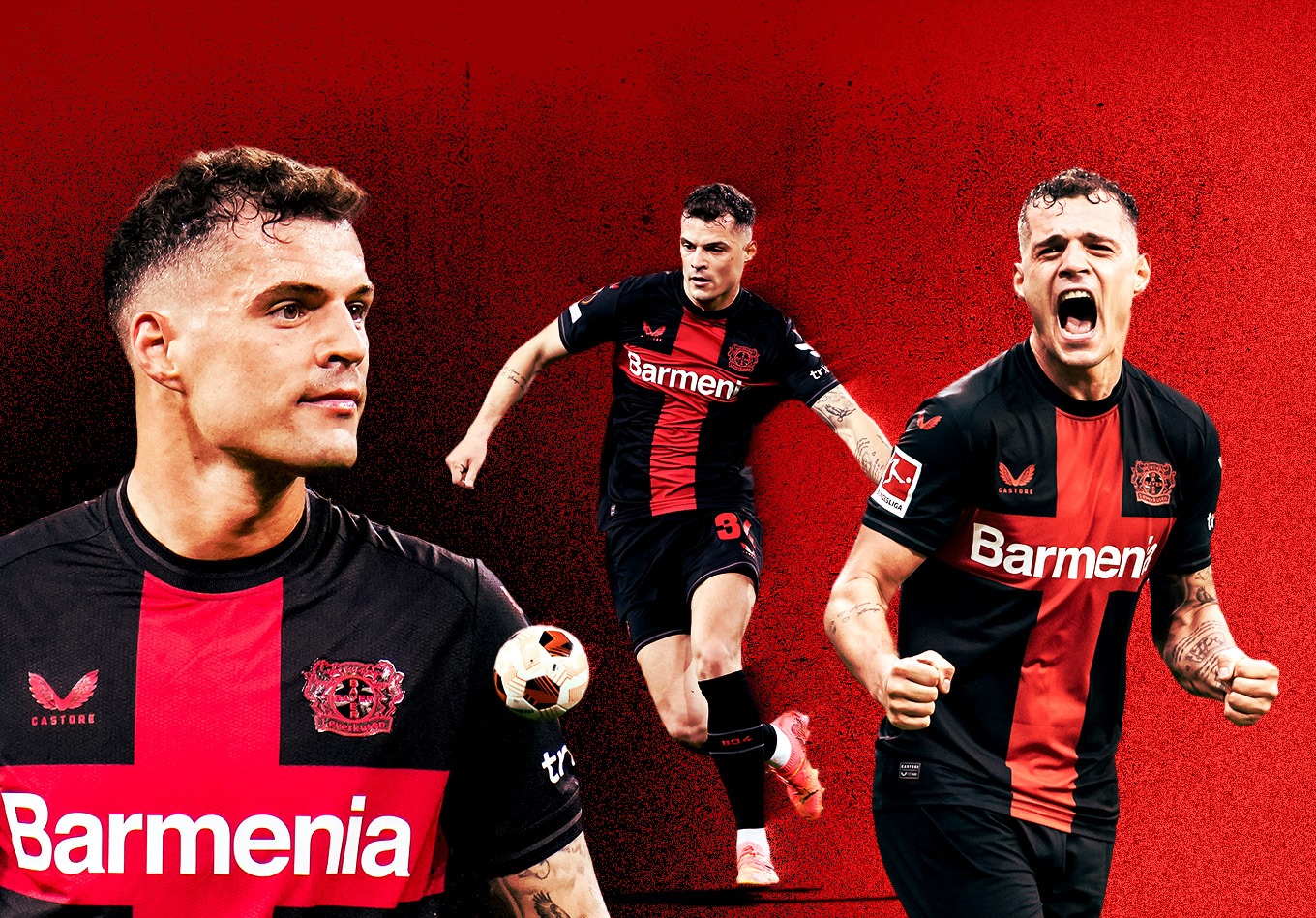Bayer Leverkusen are Bundesliga champions for the first time. A Swiss midfielder, who has touched the ball more often and completed more passes than anyone else across Europe’s top five leagues this season, sits right at the heart of this success story… we need to talk about Granit Xhaka (and shape invaders).
All heaven broke loose at the BayArena on Sunday when Bayer Leverkusen beat Werder Bremen 5-0 to win the Bundesliga for the first time in their history.
Managed by Xabi Alonso, Leverkusen have represented one of the most compelling footballing stories on the continent this season. Their triumph is their first trophy since the 1992-93 DFB-Pokal and represents the end of Bayern’s 11-season monopoly on the top-flight.
The manner of their title success has been staggering. Leverkusen set a new Bundesliga record for most games unbeaten (29) from the start of a season after winning against Werder at the weekend. But that undefeated streak isn’t just limited to domestic football. They’ve not lost in any competition in 2023-24, with their most recent victory taking them to 43 games without defeat. Alonso’s side have won 38 and drawn just five of those games.
Bayer also have a DFB-Pokal final, along with a Europa League quarter-final second leg against West Ham, to look forward to, as they chase a historic treble.
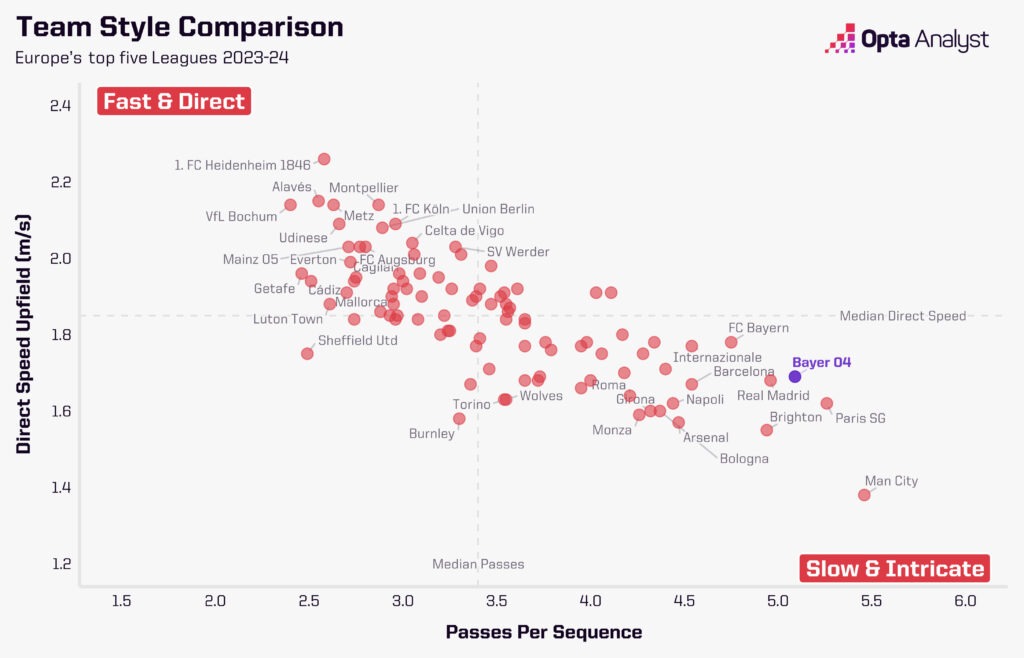
Leverkusen’s playing style places Alonso’s men in elite company. So far this season, they are averaging 5.1 passes per sequence and lead the Bundesliga with 659 sequences of 10 passes or more. And as the graphic above shows, that slow and intricate style of play is similar to that adopted by some of the biggest clubs in Europe.
Football fans are familiar with the concept of a formation that classifies a team based on the number of defenders, midfielders, and forwards. Unfortunately, formations (which Pep Guardiola has described as “just phone numbers”) don’t tell you all that much about how a team actually plays. Two identical formations can attack and defend in very different ways.
The formation is just handy notation that we can use to describe how a team is set up, but since team shapes are becoming increasingly distinct, with and without the ball, it is more practical to look at teams in terms of a sequence of shapes.
Passing the ball around in front of the opposition’s defensive shape is not effective. The key is to get inside that shape, and the most accomplished teams achieve this by penetrative passing.
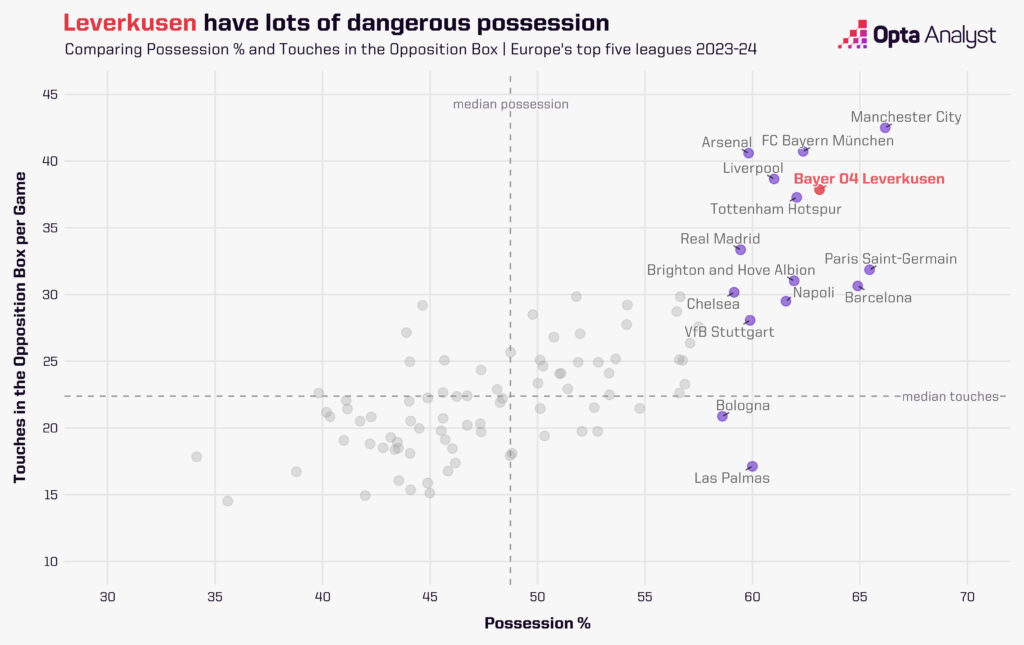
That’s an area where Leverkusen have really excelled this year. The above visual illustrates which sides in Europe’s top five leagues are best able to maintain possession in a composed manner while also penetrating the opposition’s defensive shape.
Leverkusen’s average possession is 63.1%, which ranks the German champions in fourth place behind Manchester City (66.2%), Paris Saint-Germain (65.45%) and Barcelona (64.9%), but Die Werkself are not just passing for the sake of passing. Leverkusen have also enjoyed 1,098 touches in the opposition box, ranking Alonso’s men as sixth best in Europe’s top five leagues.
Four of the sides who rank higher have played three games more – Man City (1,360), Arsenal (1,299), Liverpool (1,237) and Spurs (1,193), while Bayern Munich (1,181) also feature.
Progressing the ball into dangerous areas is extremely important.
Which brings us on to Granit Xhaka.
Midfield Matters
As a distinguished six in his own right, Alonso is aware that midfield matters. An accomplished midfield player can transform a team into a proactive force – control the middle of the field and all things are possible, but lose control of the middle and there are plenty of ways to concede. The discipline extends beyond the ability to edge a physical contest. It involves gaining control, moving your team forward and forcing the opposition back.
From a data standpoint it has proven difficult to quantify the impact that creative deep midfielders can have on team performance – anything that happens before the assist can disappear into the statistical ether.
But Opta data can help us to place the performance of the six in proper context. We can isolate what such players do well and illustrate how important shape invaders are to elite sides.
Alonso signed Xhaka from Arsenal and challenged the Swiss international to transform into a number six. For Arsenal, Xhaka operated as a left-sided eight in a 4-3-3, but for Bayer Leverkusen he’s playing as a left-sided deep midfielder alongside Exequiel Palacios in a 3-4-2-1.
His touch zone comparison map below illustrates not only how much more Xhaka has got on the ball this season, but also how his concentration of touches has moved from the left and toward the centre.
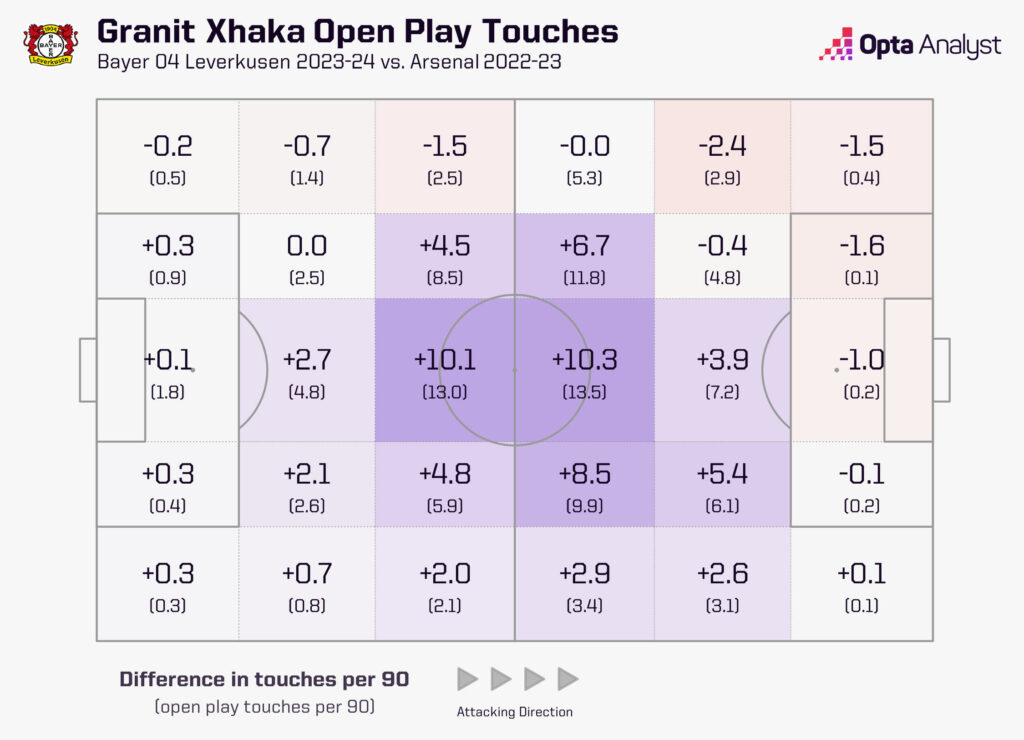
In the Premier League for Arsenal last season, Xhaka scored seven goals and registered seven assists, but for Leverkusen he’s scored just twice (zero assists). Now more than ever, it is his responsibility to build the play.
Leverkusen give him plenty of opportunity to do so, too. Xhaka touches the ball 117 times on average per game, a figure only Rodri can better in Europe’s top five leagues (119). Overall, no one in Europe’s top five leagues has touched the ball more this season (3,392) or completed more open-play passes (2,753).
Xhaka has completed 92.2% of his passing attempts – second only to his teammate Palacios in the Bundesliga (min. 1,000 minutes) – while the fact that 57% of Xhaka’s attempted passes are short (5-15 yards), 35% are medium (15-30 yards) and just 8% are long (30+ yards) illustrates how Alonso likes his side to play.
Despite operating from a deeper position, Xhaka has already picked out his teammates 350 times when passing into the final third – almost double the number of successful passes into that area he made for Arsenal last season (159). At 350 successful final-third entries, he’s the most accomplished in the category across the top five leagues in Europe.
And while he’s not registered a single assist this season, our sequences metric can highlight his value in creating goalscoring opportunities.
Only teammate Florian Wirtz (227) has been involved in more open-play attacking sequences ending a shot than Xhaka (206) in the Bundesliga this season, and in the main, the other players near the top of the list are attackers – not deep-lying midfielders.
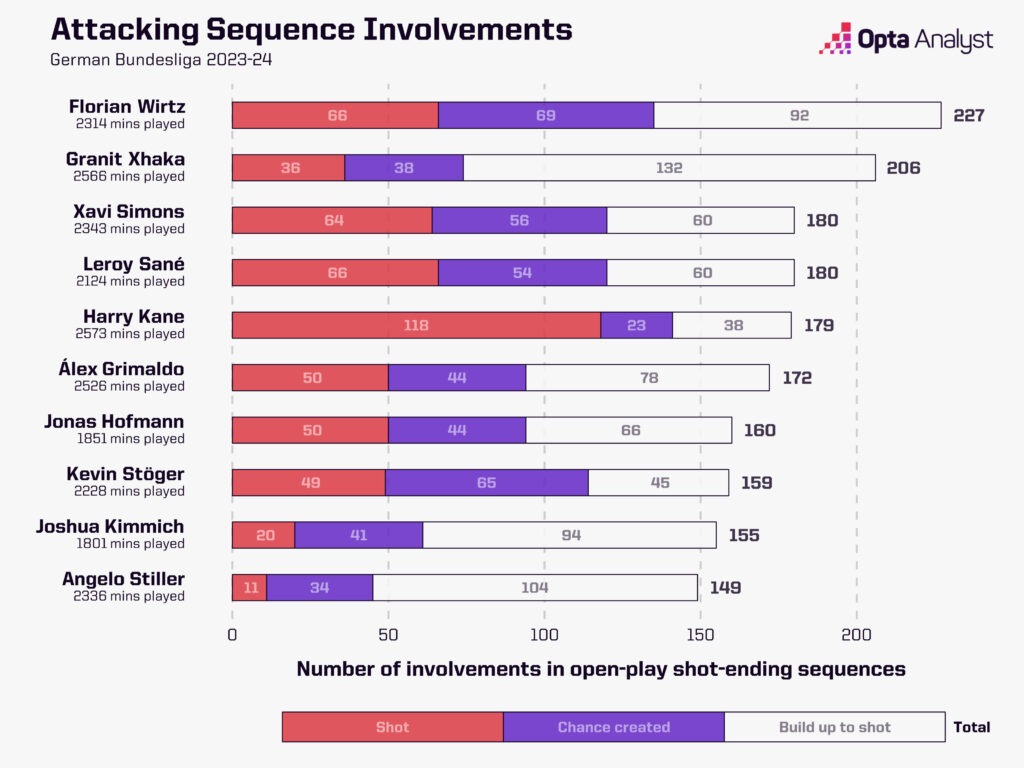
Expand that dataset across Europe and Xhaka ranks fifth across Europe’s top five leagues. Again, while players who play plenty of minutes tend to rank highly in this metric, it is illuminating that other than Rodri – who is a unicorn – all the other players in the top 10 are attackers. This highlights just how much progression the Swiss midfielder has brought to Alonso’s team.
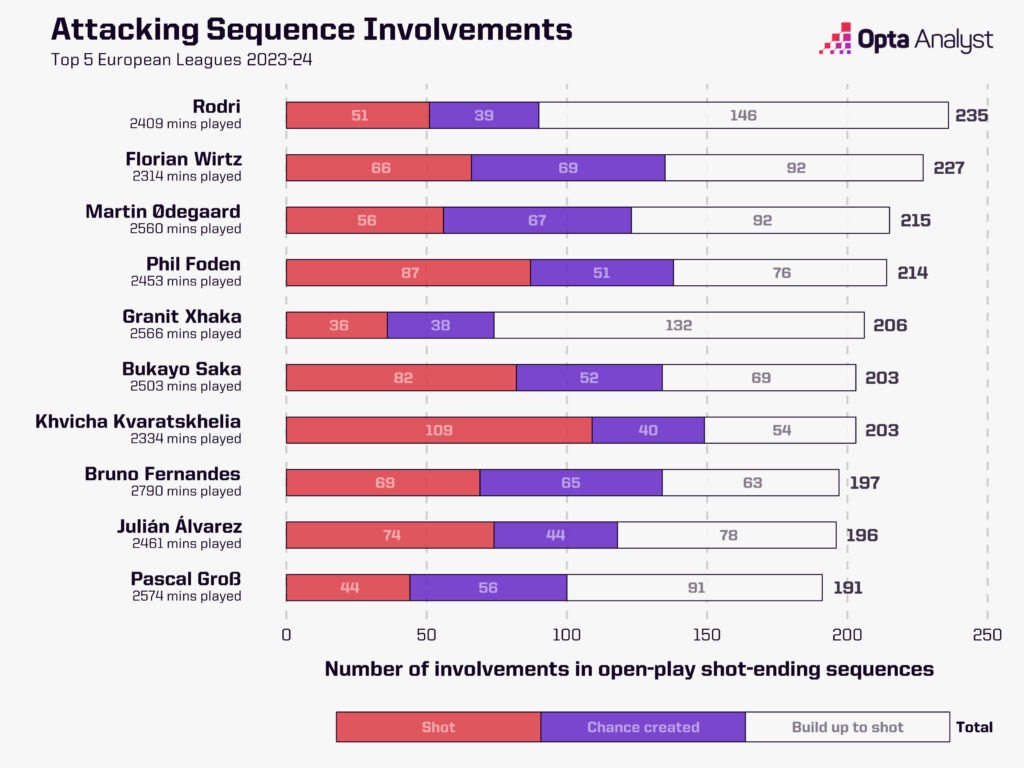
Progression, Progression, Progression
If your team wishes to access high-value attacking zones, creative midfield players are required to link the two halves of the side, to maintain the capacity to attack, to help a team to transition into its attacking shape, to form a front five or simply to manufacture a four versus three on the flanks.
Attackers, ideally, want to receive the ball high up the pitch, on the half turn, with their toes facing the opposition goal and with space to accelerate into. That ability to deliver the ball to them in that optimal situation is what can set elite midfielders apart.
In the Bundesliga this season, 20-year-old Wirtz has captured the imagination of fans. Leverkusen’s number 10 has created 71 chances while scoring 11 goals and providing 10 assists.
The thing is, Wirtz can’t be as effective without help from Xhaka. The German international has benefitted from the ability of the Swiss to deliver the ball in the best condition possible, to pass the ball progressively forward and to invade the opposition shape.
This season, Xhaka has conjured 172 progressive passes – defined as open-play passes completed in the attacking two-thirds of the pitch that moves the ball at least 25% closer to the opposition goal – a tally that ranks him as the seventh best amongst his midfield peers in Europe’s top five leagues.
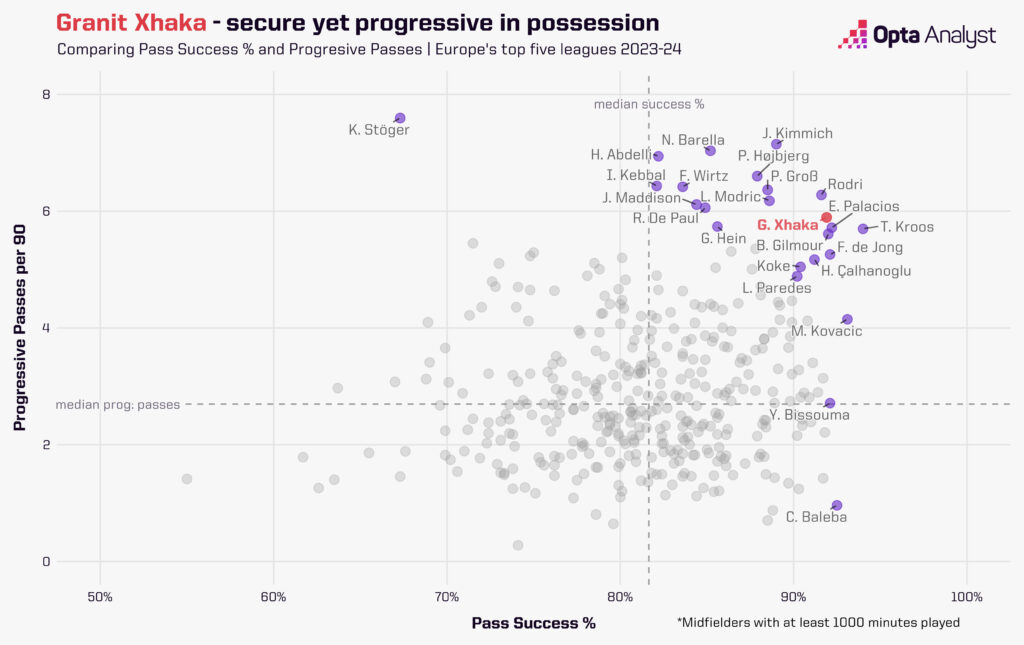
What’s more, despite being able to progress the ball forward often, Xhaka is able to do so very securely. The above graphic shows where Xhaka fits in among the most forward-thinking midfield players in Europe – he averages 5.9 progressive passes per game while rarely losing possession (92.2% passing accuracy).
Essentially, Xhaka is safe on the ball, but also capable of playing the killer pass.
Xhaka will enjoy a triumphant return to London on Thursday night to face West Ham as a league winner. The journey he has travelled from the often-vilified figure in England to become a player whom Alonso has described as “the brain” of the Bundesliga champions is analogous to the experience of midfield players generally.
The transfer market has long revolved around identifying players who are best able to convert chances when, perhaps, it should have been orientated around the players who create the moves which make the final shot inevitable. Improve the quality of that individual and your forward players can afford to be less good (and less expensive) to retrieve the situation.
The fees paid in recent windows for deep-lying midfielders like Declan Rice, Enzo Fernández and Moisés Caicedo represent three of the highest ever paid for individuals in the position. Essentially, clubs now appear willing to pay a premium for players who can crack the opposition open.
Perhaps that change in consensus thinking has come too late for 31-year-old Xhaka to ever truly be given the credit he deserves.
But in a world where Rice, Fernández and Caicedo went for a combined £307 million, Leverkusen getting Arsenal’s forgotten man for just over £20m appears to have been a masterstroke.
Enjoy this? Subscribe to our football newsletter to receive exclusive weekly content. You should also follow our social accounts over on X, Instagram, TikTok and Facebook.
